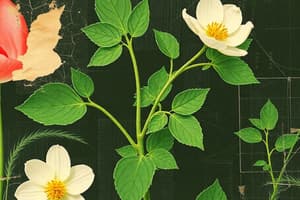Podcast
Questions and Answers
What unique adaptation allows halophytes to thrive in salty environments?
What unique adaptation allows halophytes to thrive in salty environments?
- Enhanced photosynthetic efficiency
- Increased leaf waxiness
- Ability to excrete excess salt (correct)
- Roots that filter water
Which aspect of plant ecology investigates patterns in plant communities?
Which aspect of plant ecology investigates patterns in plant communities?
- Vegetation patterns (correct)
- Biogeochemical cycles
- Plant pathology
- Conservation biology
Which practice in applied botany focuses on enhancing agricultural productivity?
Which practice in applied botany focuses on enhancing agricultural productivity?
- Plant breeding (correct)
- Biotechnology
- Plant pathology
- Conservation biology
What is the significance of studying plant evolution in the context of biodiversity?
What is the significance of studying plant evolution in the context of biodiversity?
What role do forests play in economic activities?
What role do forests play in economic activities?
Which plant group is characterized by the absence of specialized vascular tissues?
Which plant group is characterized by the absence of specialized vascular tissues?
What is the primary role of leaves in plants?
What is the primary role of leaves in plants?
What process involves the conversion of light energy into chemical energy in plants?
What process involves the conversion of light energy into chemical energy in plants?
What type of relationship is exemplified by mycorrhizal fungi and plants?
What type of relationship is exemplified by mycorrhizal fungi and plants?
Which plant adaptations would be most beneficial for survival in arid environments?
Which plant adaptations would be most beneficial for survival in arid environments?
What is the main function of fruits in flowering plants?
What is the main function of fruits in flowering plants?
Which of the following plant groups is known for possessing vascular tissues?
Which of the following plant groups is known for possessing vascular tissues?
What is the role of roots in plants?
What is the role of roots in plants?
Flashcards
Hydrophytes
Hydrophytes
Plants adapted to survive in waterlogged environments. These plants have special features to deal with the excess water, preventing waterlogging and ensuring proper gas exchange.
Halophytes
Halophytes
Plants that thrive in salty environments, like coastal areas. They have developed mechanisms to tolerate high salt concentrations.
Plant Breeding
Plant Breeding
The process of improving crops by modifying their genetic makeup. This involves selecting desirable traits and crossing plants to create better varieties.
Plant Ecology
Plant Ecology
Signup and view all the flashcards
Plant Evolution
Plant Evolution
Signup and view all the flashcards
What is Botany?
What is Botany?
Signup and view all the flashcards
What are the main plant structures?
What are the main plant structures?
Signup and view all the flashcards
What are the key functions of plants?
What are the key functions of plants?
Signup and view all the flashcards
How are plants diverse?
How are plants diverse?
Signup and view all the flashcards
How do plants interact with other organisms?
How do plants interact with other organisms?
Signup and view all the flashcards
How do plants adapt to their environment?
How do plants adapt to their environment?
Signup and view all the flashcards
Why is botany important?
Why is botany important?
Signup and view all the flashcards
Study Notes
Introduction to Botany
- Botany is the scientific study of plants, covering their structure, function, growth, reproduction, and evolution.
- Understanding plant interactions with other organisms and their environment is crucial.
- Botanists use various methods, from microscopic analysis to field observations, to study plant life.
- Botany has historical significance, influencing agriculture, medicine, and other fields.
Plant Structure
- Plants have distinct structures:
- Roots: Anchoring the plant and absorbing water and nutrients.
- Stems: Supporting the plant and transporting water and nutrients.
- Leaves: Primarily for photosynthesis, capturing sunlight energy.
- Flowers: Involved in reproduction, attracting pollinators.
- Fruits: Developing from flowers, protecting the seeds.
- Structural complexity and adaptations vary among plant groups.
Plant Functions
- Photosynthesis: Plants convert light energy into chemical energy (sugars).
- Respiration: Plants release stored energy from sugars through cellular respiration.
- Water and Nutrient Uptake: Plants absorb water and nutrients from soil via roots.
- Reproduction: Plants reproduce sexually (pollination, fertilization) or asexually.
Plant Diversity
- Plant diversity is vast, categorized based on evolutionary relationships and characteristics.
- Major plant groups include:
- Non-vascular plants (e.g., mosses, liverworts): Lack specialized vascular tissues.
- Vascular plants (e.g., ferns, gymnosperms, angiosperms): Possess vascular tissues for transport.
- Angiosperms (flowering plants): Highly diverse, featuring flowers and fruits.
Plant Interactions
- Plants interact with other organisms:
- Mutualistic relationships (e.g., mycorrhizal fungi): Both organisms benefit.
- Competition: Species compete for resources.
- Herbivory: Consumption of plants by herbivores.
- Disease: Plant diseases caused by pathogens.
- These interactions impact plant communities and ecosystems.
Plant Adaptations
- Plants adapt to diverse environments:
- Xerophytes (arid): Adaptations to conserve water (e.g., thick cuticles, reduced leaves).
- Hydrophytes (aquatic): Features for dealing with excess water.
- Halophytes (salty): Tolerance to salinity.
- Diverse plant groups show unique adaptations.
Economic Importance
- Agriculture relies on crops for food production.
- Plant-derived medicines offer various medicinal compounds.
- Forests provide wood, fiber, and other crucial resources to industries and livelihoods.
- Diverse industrial applications utilize plant-derived materials.
Applied Botany
- Plant breeding aims to improve crops and yields.
- Conservation biology protects endangered plants and their habitats.
- Biotechnology uses genetic engineering to modify plants.
- Plant pathology studies plant diseases and controls them.
The Study of Plant Evolution
- Plant evolution led to diversification, observable through fossils showing evolutionary changes over time.
- Phylogenies depict relationships among plant lineages.
- Understanding plant evolution is essential for understanding Earth's biodiversity.
Plant Ecology
- Plant ecology examines interactions between plants and their environment.
- This includes vegetation patterns, plant community structures, and their role in biogeochemical cycles.
Studying That Suits You
Use AI to generate personalized quizzes and flashcards to suit your learning preferences.




